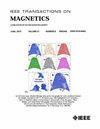Nondestructive Ferromagnetic Resonance Measurements Validate the Efficacy of a Seed Layer in Cobalt Magnetic Nanowire Fabrication
IF 2.1
3区 工程技术
Q3 ENGINEERING, ELECTRICAL & ELECTRONIC
引用次数: 0
Abstract
Magnetic nanowires (MNWs) have been proposed for use in numerous applications due to their tunability and scale, but due to the same tunability that makes MNWs so versatile, tight quality control is needed to make the transition from research labs to industry. Currently, template-assisted electrodeposition is a promising fabrication method, but there is no quick, low-cost method to effectively quantify the fill factor (FF) of the templated wires. Here, we evaluate the efficacy of a copper seed layer to fabricate cobalt MNWs using quantitative ferromagnetic resonance (FMR). The deposition quality is assessed by FF and saturation magnetization (MS). First, the quality is evaluated by common, qualitative, or semiquantitative methods, which are then compared to the quantitative values measured from FMR. The copper seed layer is demonstrated to improve FF while maintaining MNW quality. For the seeded sample, FMR measured FF at 12.3%非破坏性铁磁共振测量验证种子层在钴磁性纳米线制造中的有效性
磁性纳米线(MNWs)由于其可调性和规模而被提出用于许多应用,但由于同样的可调性使MNWs如此通用,因此需要严格的质量控制才能从研究实验室过渡到工业。目前,模板辅助电沉积是一种很有前途的制造方法,但没有一种快速、低成本的方法来有效地量化模板线的填充因子(FF)。在这里,我们利用定量铁磁共振(FMR)技术评估了铜种子层制备钴MNWs的有效性。通过FF和饱和磁化(MS)评价沉积质量。首先,通过普通的、定性的或半定量的方法来评估质量,然后将其与FMR测量的定量值进行比较。铜种子层在保持MNW质量的同时提高了FF。对于有籽样品,FMR测得FF值为12.3% $\pm ~0.4$ %, MNW MS为$1.64~\pm ~0.10$ t。对于无籽样品,FMR测得FF值为9.0% $\pm ~0.4$ %, MNW MS为$1.62~\pm ~0.13$ t。这些定量测量结果与所有定性和半定量结果相吻合,表明无损FMR是一种定量FF和快速评价模板MNWs质量的可行方法。
本文章由计算机程序翻译,如有差异,请以英文原文为准。
求助全文
约1分钟内获得全文
求助全文
来源期刊

IEEE Transactions on Magnetics
工程技术-工程:电子与电气
CiteScore
4.00
自引率
14.30%
发文量
565
审稿时长
4.1 months
期刊介绍:
Science and technology related to the basic physics and engineering of magnetism, magnetic materials, applied magnetics, magnetic devices, and magnetic data storage. The IEEE Transactions on Magnetics publishes scholarly articles of archival value as well as tutorial expositions and critical reviews of classical subjects and topics of current interest.
 求助内容:
求助内容: 应助结果提醒方式:
应助结果提醒方式:


